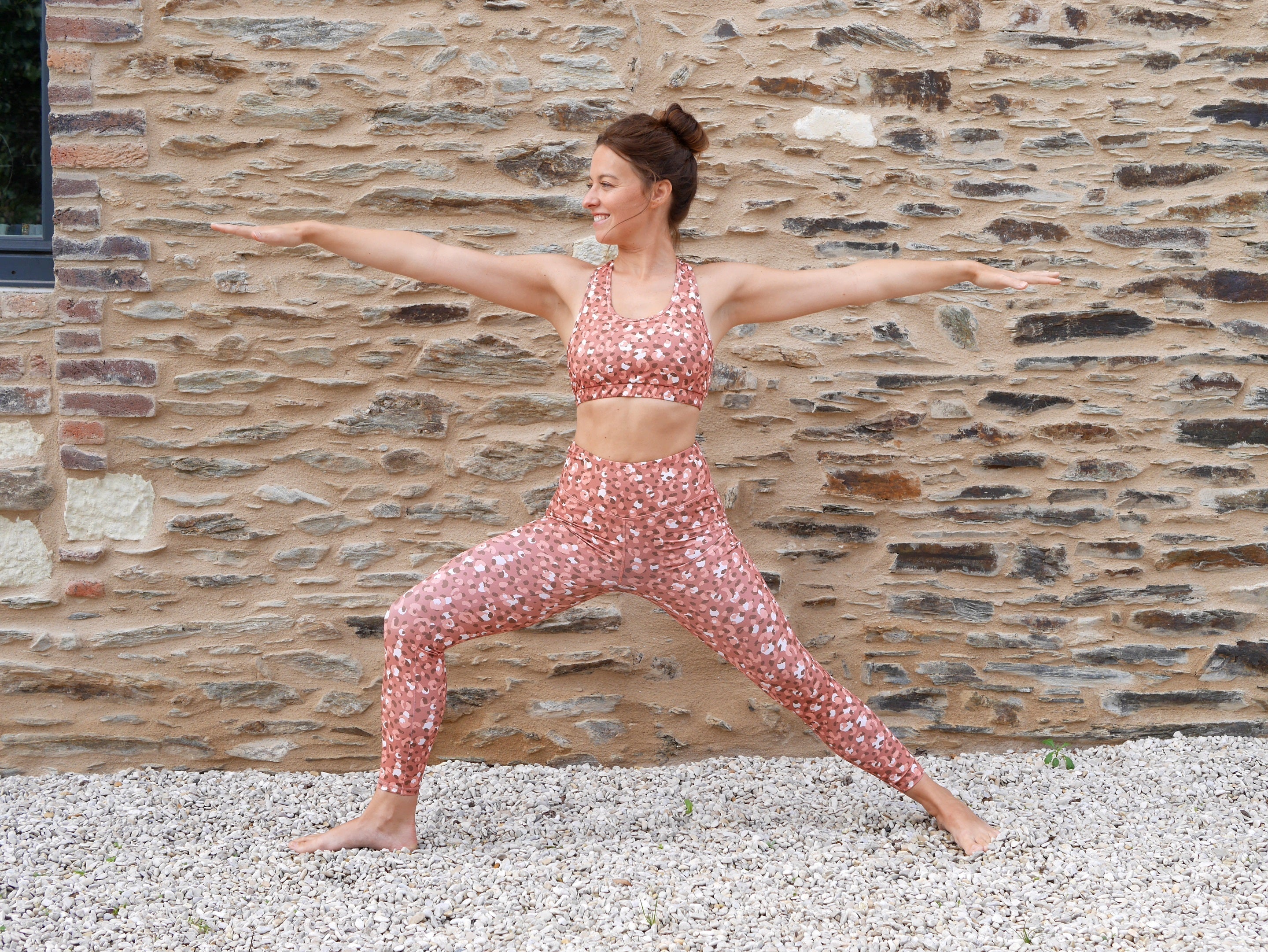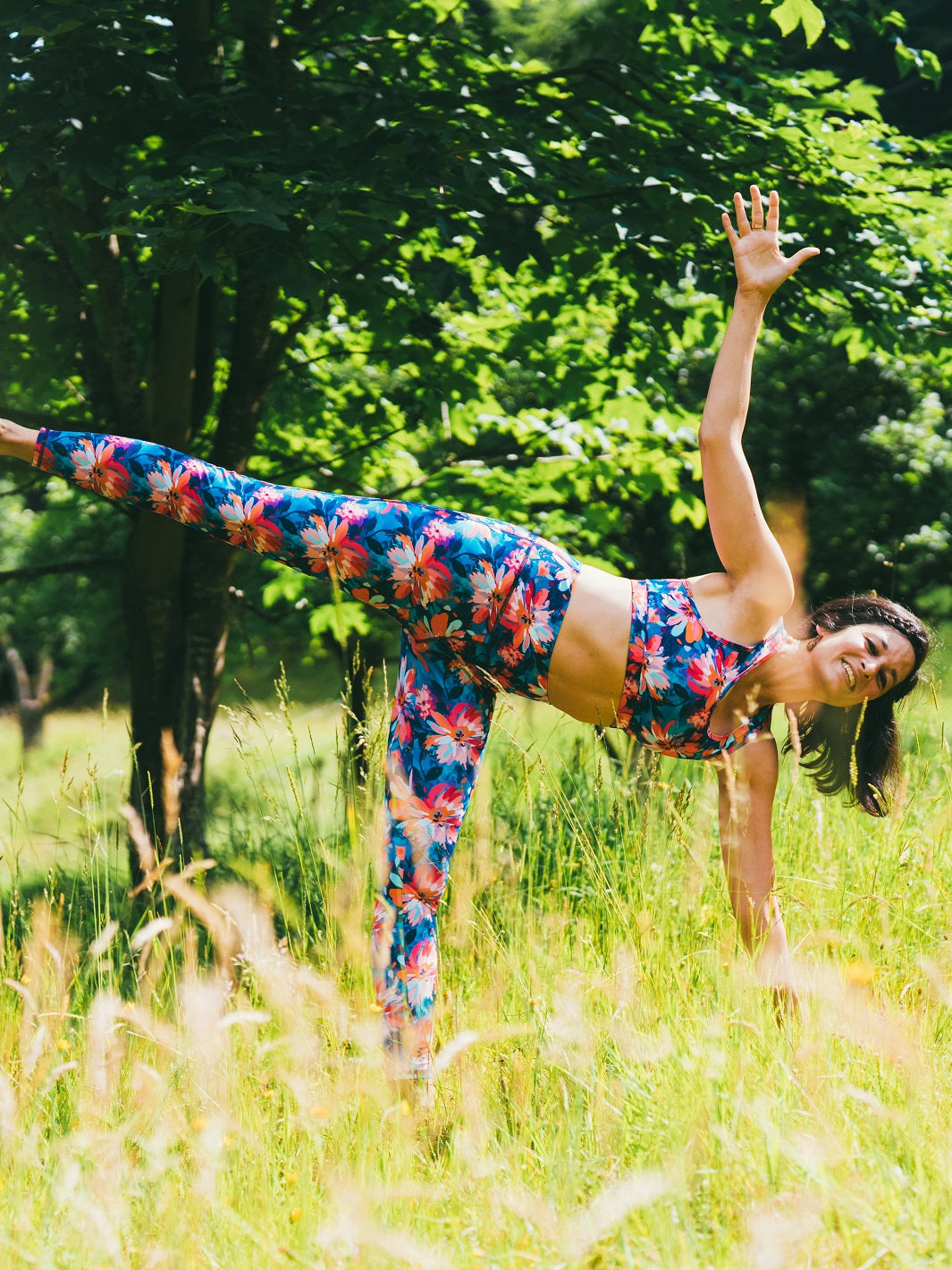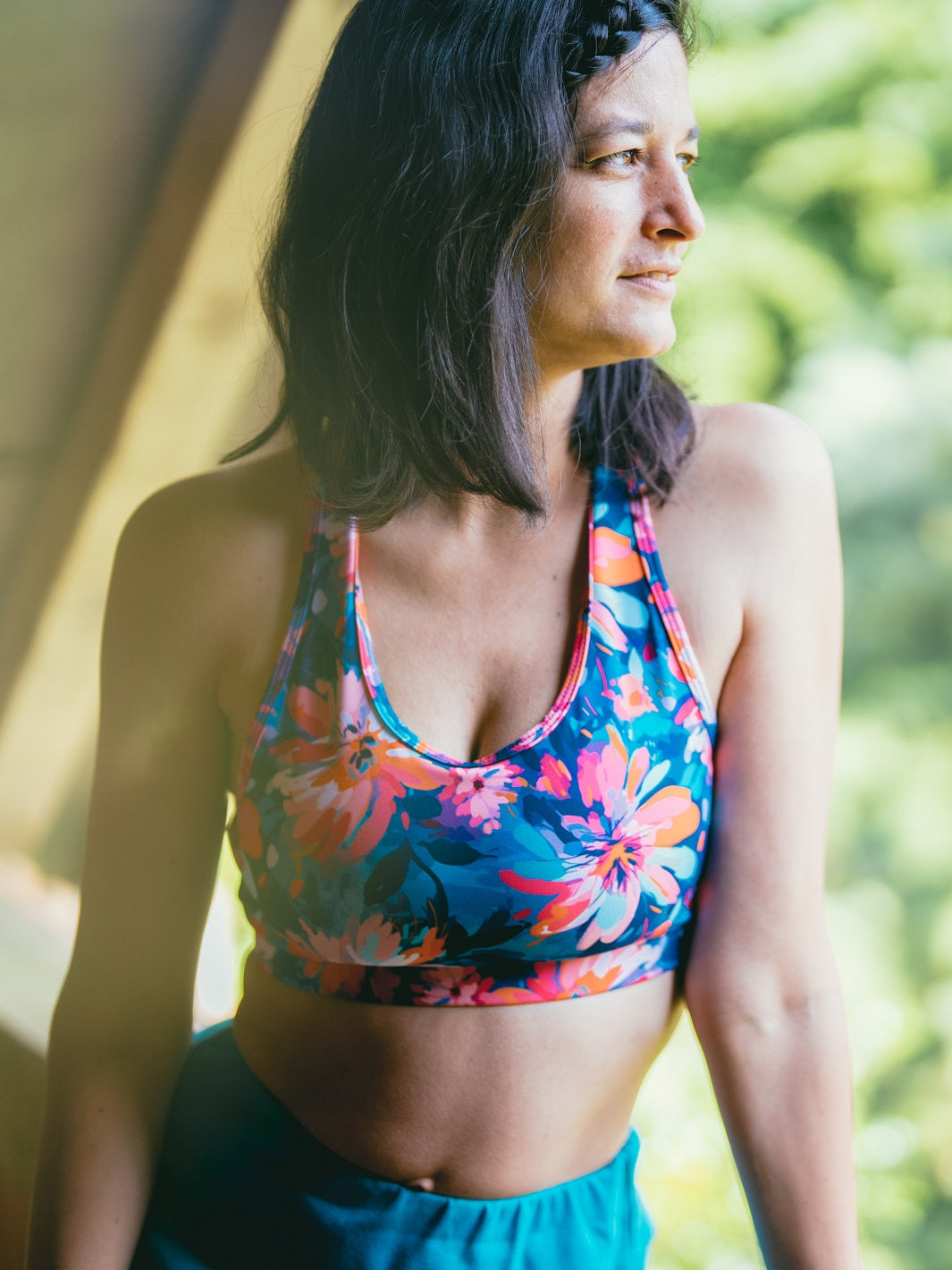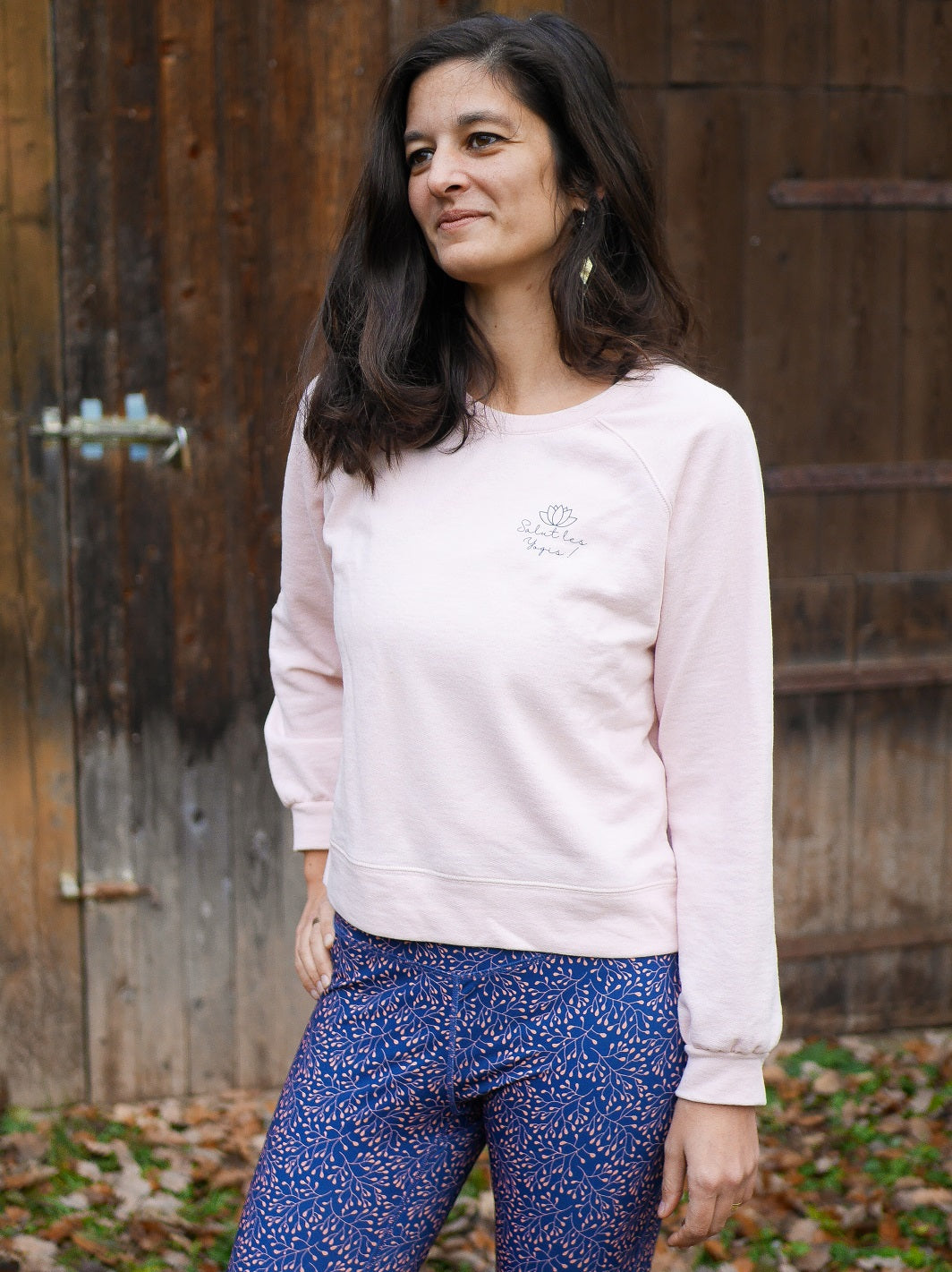Yoga is an ancient practice that combines strength, flexibility, and balance.
Among the emblematic postures of this discipline, the Warrior posture, also called Virabhadrasana in Sanskrit, is one of the most practiced and venerated.
This powerful and symbolic posture strengthens not only the body, but also the mind.
It comes in three main variations, each with its own benefits and requirements.
Let's discover together the Warrior pose in its three variations, its benefits, its techniques, and how to integrate it effectively into a yoga practice.
If you like this style of article, also check out the pigeon yoga pose.

1. Origin and Meaning of the Warrior Stance
The Warrior pose is named after Virabhadra, a legendary warrior in Hindu mythology.
According to legend, Virabhadra was created by the god Shiva to avenge the death of his beloved Sati.
The Warrior pose represents strength, determination, and the inner power needed to overcome obstacles.
It also symbolizes the courage to face challenges, approaching them with calm and balance.
The Warrior pose therefore has a spiritual and energetic dimension: it connects us to our inner strength, stimulates our determination, and allows us to release the tensions accumulated in the body.
2. The Benefits of the Warrior Pose
The Warrior pose is both a physical and mental posture. It brings many benefits:
1. Muscle strengthening : It works the muscles of the legs, hips, shoulders, and back. It also engages the abdominals to stabilize the core.
2. Improved balance and coordination : The Warrior requires concentration to maintain balance and coordinate upper and lower body movements.
3. Hip and Shoulder Stretch : The pose stretches the hips, thighs, shoulders, and back, improving flexibility and reducing tension.
4. Improved Posture : By opening the chest and lengthening the spine, the Warrior strengthens posture and body awareness.
5. Boost Confidence and Focus : This powerful and grounding pose helps build confidence and determination.

3. Warrior Pose I (Virabhadrasana I)
The first variation of Warrior is Warrior I pose, which is a pose of strength and openness.
3.1 Technique for performing Warrior I pose
Starting Position : Begin in Mountain Pose (Tadasana) with your feet together and arms at your sides.
Big Step Back : Take a big step back with your right foot, keeping your hips pointed forward.
Leg alignment : The front foot is turned 90° and the knee is bent to form a right angle with the ankle, while the back foot is angled at approximately 45°.
Raise your arms : Inhale deeply and raise your arms towards the sky, bringing your palms together or keeping them apart, depending on your comfort.
Core Alignment : Ensure your hips are aligned forward. Engage your abs to protect your lower back.
Breathing : Stay in this position for 5 to 10 breaths, maintaining stability and focus.
3.2 Specific benefits
Warrior I pose opens the ribcage and stimulates the heart chakra, promoting energy and emotional openness.
It also strengthens the lower body and boosts confidence.
Humble Warrior pose (or Baddha Virabhadrasana ) is a variation of Warrior I pose (Virabhadrasana I) in yoga.
This posture combines strength, flexibility, and humility, inviting internalization and letting go.
Here is how to practice the humble warrior and some benefits of this posture:
3.3 Steps to Entering the Humble Warrior Stance
- Start in Warrior I position :
- Place one foot in front and the other behind, with your hips facing forward.
- Bend your front leg 90°, keeping your knee aligned with your ankle. Your back leg remains straight.
- Anchor both feet in the ground and stretch the spine upwards.
- Join your hands behind your back :
- Interlace your fingers behind your back, or if possible, place your palms together in a reverse prayer mudra (fingers pointing down).
- Stretch your arms, opening your heart and shoulders.
- Lean forward :
- Slowly bend your torso forward, keeping your back as straight as possible.
- Direct your head toward the inside of your front thigh, while raising your hands toward the ceiling to open your shoulders and chest.
- Release the back of your neck and let your head gently drop toward the floor, keeping your gaze toward the floor or inward.
- Breathing and holding :
- Breathe deeply into the pose, finding stability and releasing any tension in the shoulders and neck.
- Hold this position for a few breaths, then gently straighten up.
- Change sides :
- Return to Warrior I and switch legs to repeat on the other side.

4. Warrior Pose II (Virabhadrasana II)
Warrior II is a more lateral variation of the pose. This version emphasizes stability and endurance.
4.1 Technique for performing Warrior II pose
Starting Position : In Mountain Pose, open your legs and place your feet wider than hip-width apart.
Front foot turned 90° : Turn the right foot forward and the left foot 90°.
Bend the front knee : The front knee should be bent to form a right angle, aligned above the ankle.
Arms horizontal : Stretch your arms out to shoulder height, keeping your palms facing the floor and your shoulders relaxed.
Forward Gaze : Fix your gaze over the front hand, while keeping your spine long.
Breathing : Hold the posture for 5 to 10 breaths.
4.2 Specific benefits
Warrior II pose strengthens the quadriceps, glutes, and arm muscles.
It also opens the hip area and improves concentration.
By stimulating the root chakra (Muladhara), it promotes grounding and emotional stability.

5. Reverse Warrior Pose
In French, the reverse warrior posture is called the reverse warrior or sometimes the inverted warrior .
In Sanskrit it is called Viparita Virabhadrasana .
This variation of Warrior II Pose (Virabhadrasana II) is a beautiful opening pose that stretches the side of the body and strengthens the legs while developing flexibility in the spine.
5.1 Steps to Enter Reverse Warrior Pose
Begin in Warrior II Pose ( Virabhadrasana II ):
-
- Place one foot forward with your front knee bent at a 90° angle.
- Keep your back leg straight and your back foot firmly planted on the ground with your toes pointed slightly inward.
- The hips and shoulders are open to the side, and the arms are extended parallel to the floor.
Inhale and raise your front arm :
-
-
- On an inhale, raise your front arm toward the ceiling, palm facing inward, stretching the entire side of your body.
- Let the other hand (the one on your back arm) move down slightly along your back thigh, without applying pressure.
-
Stretch the torso backward :
-
-
-
- Lean your torso back, keeping your legs strong and well anchored.
- Continue to engage your leg muscles to keep the front knee stable over the ankle.
- Lengthen your spine and open your chest upwards and slightly backwards, without compressing your lower back.
-
-
Look up or toward your raised hand (depending on your cervical comfort):
-
- If possible, look up at the ceiling, toward your raised hand, or keep your gaze straight ahead if that's more comfortable.
Breathe deeply and hold :
-
- Take a few deep breaths, feeling the stretch throughout your entire body.
- To come out of the pose, gently lower back into Warrior II before repeating on the other side.
5.2 Benefits of the Reverse Warrior Pose
- Side Body Stretch : The Reverse Warrior helps stretch the side muscles of the rib cage, waist, and obliques.
- Leg and Ab Strengthening : As in all warrior variations, the legs work intensely to stabilize the body.
- Chest and Shoulder Opener : This pose helps open the chest, releasing tension in the thoracic region.
- Improved spinal flexibility : Gently, the reverse warrior allows you to mobilize the spine while respecting its natural alignment.
5.3 Posture Tips
- Keep your front knee aligned with your ankle to protect the joint.
- Focus on lengthening the spine rather than bending, being careful not to compress the lower back.
- If you feel any tension, reduce the stretch of your torso back and lightly engage your abdominals to stabilize the posture.
The Reverse Warrior is a powerful pose that combines strength, grace, and flexibility, ideal for energizing and balancing your yoga practice!

6. Warrior Pose III (Virabhadrasana III)
Warrior III is a posture of balance and power that requires great concentration.
This version is more demanding because it mobilizes the stabilizing muscles and requires good balance.
6.1 Technique for performing Warrior III pose
Starting Position : Begin in Warrior I pose.
Balance Transition : Slowly lean your trunk forward while lifting your back leg.
Body Alignment : Raise your back leg until it is in line with your torso, forming a straight line from your hands to your heel.
Arms outstretched : You can keep your arms straight out in front of you or bring them down alongside your body.
Forward gaze : Keep your gaze directed toward a fixed point to maintain balance.
Breathing : Stay in this position for 3 to 5 breaths.
6.2 Specific benefits
Warrior III tones the muscles of the legs, glutes, back, and arms. It significantly improves balance and strengthens concentration.
This posture activates the solar plexus chakra, which helps to strengthen determination and self-confidence.

7. Variations and Adaptations of the Warrior Stance
To adapt these postures to individual needs or to vary the intensity, here are some modification options:
- Humble Warrior (Baddha Virabhadrasana) : This variation of Warrior I involves clasping your hands behind your back and leaning forward. This increases chest openness and strengthens shoulder flexibility.
- Reverse Warrior : Starting from Warrior II pose, gently lean your torso back, extending your arm toward the ceiling. This variation provides an excellent lateral stretch and opens the rib cage.
- Warrior with a Wall Stand : Beginners or those with balance issues can lean against a wall to practice Warrior III. This helps stabilize the body while working on alignment.
- Warrior with a Chair : For those with mobility limitations, Warrior Pose can be performed while sitting in a chair. This allows for strength and flexibility work without excessive stress on the joints.

8. Tips for Effective Practice
To fully benefit from the benefits of Warrior Pose, here are some tips:
- Listen to your body : If you feel pain (not just discomfort), gently return to a neutral position.
- Breathe deeply : Conscious breathing is essential for maintaining stamina and calming the mind.
- Engage your core : Contract your abs to protect your lower back, especially in Warrior I and III versions.
- Work your way up : If you are a beginner, start with Warrior I and II before trying Warrior III.
Conclusion
Warrior Pose and its variations are pillars of yoga, symbolizing strength, balance, and focus.
Incorporating these postures into a regular practice can strengthen the body and mind while bringing a sense of accomplishment and inner stability.
Whether you're a beginner or an advanced practitioner, explore the different variations of Warrior to find the ones that resonate best with you, and let this pose guide you into a more grounded and powerful practice.






Leave a comment